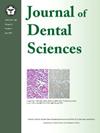特殊需要患者在牙科手术过程中意外摄入或吸入异物:一项回顾性研究
IF 3.1
3区 医学
Q1 DENTISTRY, ORAL SURGERY & MEDICINE
引用次数: 0
摘要
背景与目的意外误食或误吸异物(AIAOFB)是常规牙科手术的潜在并发症,特别是在残疾和合作有限的特殊需要患者中。本研究旨在分析2011 - 2024年10例特殊需要患者在牙科手术过程中发生AIAOFB的情况及特点。材料和方法本研究回顾了12例发生在牙科手术过程中或牙科诊所外的AIAOFB病例。本研究收集于2011 - 2024年台湾大学附属医院特殊口腔保健中心的12例病例。2例因未发现可能的摄入物而被排除。分析内容包括摄入物品的性质、所涉及的牙科程序、损伤类型、医生经验和随后的治疗。结果幸运的是,未发生异物吸入气管或支气管的情况;所有10个异物都被消化系统吸收。AIAOFB患病率为0.017%(10/57,714)。通过内窥镜手术成功去除各种异物,如毛刺和金属丝。此外,牙齿或假冠在一到两周内自然通过消化道,没有并发症。结论本研究突出了10例特殊需要患者AIAOFB的特点。警惕是预防此类事件的关键,牙医必须做好充分的准备,当患者在牙科治疗过程中无意中吸入或吞咽牙科器械或材料时,及时诊断和处理这些紧急情况。本文章由计算机程序翻译,如有差异,请以英文原文为准。
Accidental ingestion or aspiration of foreign bodies in the special needs patients during the dental procedures: A retrospective study
Background and purpose
Accidental ingestion or aspiration of foreign bodies (AIAOFB) is a potential complication during the routine dental procedures, particularly in the special needs patients due to disability and limited cooperation. This study aimed to analyze the prevalence and characteristics of 10 cases of AIAOFB in the special needs patients during the dental procedures from 2011 to 2024.
Materials and methods
This retrospective study reviewed 12 AIAOFB cases occurring either during the dental procedures or outside the dental clinic. These 12 cases were collected from the Oral Health Care Center for Special Needs at National Taiwan University Hospital from 2011 to 2024. Two cases were excluded because the possible ingested objects were not found. The analysis included the nature of ingested objects, dental procedures involved, types of impairment, practitioner experience, and subsequent treatments.
Results
Fortunately, no instance of foreign body aspiration into the trachea or bronchi occurred; all 10 foreign bodies were ingested into the digestive system. Thus, the prevalence of AIAOFB was 0.017 % (10/57,714). Various foreign objects, such as burs and wires, were successfully removed via endoscopic operation. Additionally, the teeth or prosthetic crowns were spontaneously passed through the digestive tract within one to two weeks without complications.
Conclusion
This study underscores the characteristics of 10 AIAOFB cases in the special needs patients. Vigilance is essential in preventing such incidents, and dentists must be well prepared to promptly diagnose and manage these emergencies when patients inadvertently aspirate or swallow the dental instruments or materials during the dental treatments.
求助全文
通过发布文献求助,成功后即可免费获取论文全文。
去求助
来源期刊

Journal of Dental Sciences
医学-牙科与口腔外科
CiteScore
5.10
自引率
14.30%
发文量
348
审稿时长
6 days
期刊介绍:
he Journal of Dental Sciences (JDS), published quarterly, is the official and open access publication of the Association for Dental Sciences of the Republic of China (ADS-ROC). The precedent journal of the JDS is the Chinese Dental Journal (CDJ) which had already been covered by MEDLINE in 1988. As the CDJ continued to prove its importance in the region, the ADS-ROC decided to move to the international community by publishing an English journal. Hence, the birth of the JDS in 2006. The JDS is indexed in the SCI Expanded since 2008. It is also indexed in Scopus, and EMCare, ScienceDirect, SIIC Data Bases.
The topics covered by the JDS include all fields of basic and clinical dentistry. Some manuscripts focusing on the study of certain endemic diseases such as dental caries and periodontal diseases in particular regions of any country as well as oral pre-cancers, oral cancers, and oral submucous fibrosis related to betel nut chewing habit are also considered for publication. Besides, the JDS also publishes articles about the efficacy of a new treatment modality on oral verrucous hyperplasia or early oral squamous cell carcinoma.
 求助内容:
求助内容: 应助结果提醒方式:
应助结果提醒方式:


